- News
- Reviews
- Bikes
- Accessories
- Accessories - misc
- Computer mounts
- Bags
- Bar ends
- Bike bags & cases
- Bottle cages
- Bottles
- Cameras
- Car racks
- Child seats
- Computers
- Glasses
- GPS units
- Helmets
- Lights - front
- Lights - rear
- Lights - sets
- Locks
- Mirrors
- Mudguards
- Racks
- Pumps & CO2 inflators
- Puncture kits
- Reflectives
- Smart watches
- Stands and racks
- Trailers
- Clothing
- Components
- Bar tape & grips
- Bottom brackets
- Brake & gear cables
- Brake & STI levers
- Brake pads & spares
- Brakes
- Cassettes & freewheels
- Chains
- Chainsets & chainrings
- Derailleurs - front
- Derailleurs - rear
- Forks
- Gear levers & shifters
- Groupsets
- Handlebars & extensions
- Headsets
- Hubs
- Inner tubes
- Pedals
- Quick releases & skewers
- Saddles
- Seatposts
- Stems
- Wheels
- Tyres
- Health, fitness and nutrition
- Tools and workshop
- Miscellaneous
- Cross country mountain bikes
- Tubeless valves
- Buyers Guides
- Features
- Forum
- Recommends
- Podcast
review
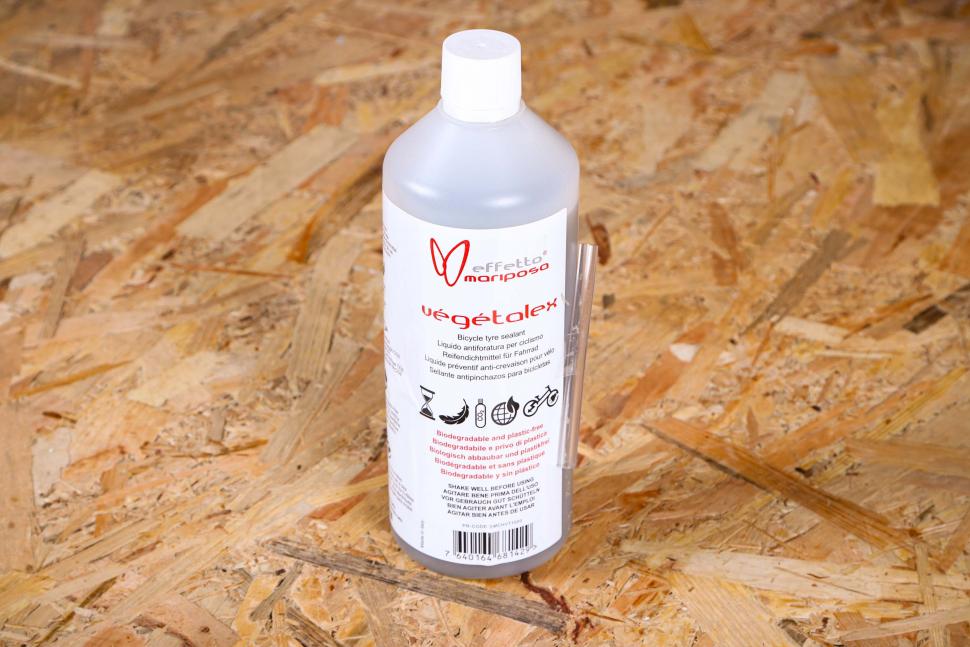 2020 Effetto Mariposa Végétalex Tyre Sealant
2020 Effetto Mariposa Végétalex Tyre Sealant£24.00
VERDICT:
Effective, simple, plant-based tyre sealant that's both eco and plain good
Effective
Eco friendly
Easy to use
Good price
Needs a generous application
Hole plugging claims 2-3mm down on rivals
Weight:
1,000g
Contact:
At road.cc every product is thoroughly tested for as long as it takes to get a proper insight into how well it works. Our reviewers are experienced cyclists that we trust to be objective. While we strive to ensure that opinions expressed are backed up by facts, reviews are by their nature an informed opinion, not a definitive verdict. We don't intentionally try to break anything (except locks) but we do try to look for weak points in any design. The overall score is not just an average of the other scores: it reflects both a product's function and value – with value determined by how a product compares with items of similar spec, quality, and price.
What the road.cc scores meanGood scores are more common than bad, because fortunately good products are more common than bad.
- Exceptional
- Excellent
- Very Good
- Good
- Quite good
- Average
- Not so good
- Poor
- Bad
- Appalling
Effetto Mariposa Végétalex Tyre Sealant uses the power of olives to clog those pesky holes in your tyres. During a month of testing, I've been impressed with how it's repeatably sealed punctures quickly and easily, but you do require slightly more than other sealants. Nevertheless, it's still excellent value and should be better for the environment as well.
Most tyre sealants are made of two parts: the particles which plug the holes, and the carrier that transports them there. This carrier is often either natural or synthetic latex, but in the case of Végétalex, it's a sugar-based Xanthan gum from eucalyptus trees. This gum degrades quickly in the environment.
While natural latex comes from a rubber trees and biodegrades too, the problem is the ammonia many latex sealants also contain – not to mention any microplastic or metallic particles that could be in there as plugging agents. These days manufacturers seem more aware, though, hence the likes of Panaracer Seal Smart that uses ground walnut shells as its hole-plugging weapon.
Pit stopper
Effetto Mariposa, by contrast, uses olive pits, an extremely abundant waste product of oil production. And after a month and a bit of testing, I've been thoroughly impressed with the performance of Végétalex.
Application
The 1L bottle comes with a tube for sending it through the valve after the core is removed. The scale on the side of the bottle is handy, and it's actually clear and easy to read too – the liquid doesn't leave the same obscuring residue as, for example, MucOff's No Puncture Hassle Tubeless Sealant.
Végétalex is thinner than some other sealants I've used, which makes it easy to slosh around the tyre for even coverage. The small amount of mess after inflation is easy to clean up, too, and doesn't get smeared around like latex sealants can. If you find yourself on the roadside with less air than required, it's worth noting that Végétalex is compatible with CO2.
> Tubeless tyres: 14 hidden pitfalls you should try and avoid
I tested this in a set of 28mm road tyres and a pair of mountain bike tyres. The iCaffetalex app, available for Apple and Android devices, is a easy way to calculate how much sealant you need, but Effetto Mariposa say to add a further 20%.
For my road tyres the app calculated 40ml, and I settled at around 50ml per tyre on the road and 160ml in my big, 3.2in mountain bike tyres. Overall, I reckon I'm using about 10% more Végétalex than other sealants, which doesn't concern me much, but it might on a hill climb bike.
Performance
Out on the road and trails I've been pulling multiple thorns out my tyres all month. The Végétalex has sealed them all within a few spins of the wheel. It also sealed a larger hole (around 4mm) inflicted on the road by a sharp piece of flint. Effetto Mariposa's 5mm hole-plugging claims are easy to believe, though it's slightly down on some other sealants' claims.
After only a month and a bit it's hard to comment on durability, but three months is the claimed worst-case scenario and 'most tyre applications' supposedly last more than six months. If you're wondering what a worst-case scenario looks like, it's a small amount of sealant in very porous tyres in a hot climate. Judging by its condition so far, it seems in line with other sealants such as Juice Lubes Tyre Juice.
At £24 for 1L, you're not paying a premium for the eco credentials, either – in fact, it's a strong price. Muc-Off No Puncture Hassle and Peaty's Tubeless Sealant are both £29.99 per litre, Bontrager TLR Sealant is £24.99, and Stans NoTubes Race Sealant is £32.
Overall
Végétalex is good whether you're concerned about the environment or not. It works well, proves excellent value and can plug holes up to at least 4mm. This might not be the product that saves the world, but it's saved me from using at least three tubes, and if we all switch to ingenious products such as this one, it might just make a difference.
Verdict
Effective, simple, plant-based tyre sealant that's both eco and plain good
road.cc test report
Make and model: Effetto Mariposa Végétalex Tyre Sealant
Size tested: 1000ml
Tell us what the product is for and who it's aimed at. What do the manufacturers say about it? How does that compare to your own feelings about it?
Effetto Mariposa says: "As we should all do our best to reduce our impact on the environment, we started working on a plant-based sealant that was both good with nature and very effective – similar to Caffélatex – against punctures. It took us more than two years of development, but we can now say Végétalex has exceeded our expectations."
Tell us some more about the technical aspects of the product?
Unique plant-based puncture repairing ingredients (that's why we call it Végétalex)
Extremely durable
Adds little weight to wheels, following the suggested quantities (see iCaffelatex app + 20%)
Compatible with the use of CO2 cartridges
Biodegradable and totally plastic free
Being very low maintenance (in most cases, it will last a full season of riding) it's ideal also for e-bikes
Easy to clean
Rate the product for quality of construction:
8/10
Bottle and tube make application easy and fairly mess free; scale on bottle is also good.
Rate the product for performance:
7/10
Rate the product for durability:
7/10
So far so good: Effetto Mariposa claims at least three months, and after almost two it's still liquidy! I think it's on a par with rivals.
Rate the product for weight (if applicable)
5/10
You need around 10% more of this than other sealants, which equates to about 5g per typical road wheel or 20g per mountain bike wheel. Not horrendous.
Rate the product for value:
8/10
You do need slightly more of it, but this still seems quite an economical way of buying 1L of sealant. However, if you use a lot it's worth noting that no larger sizes are available currently.
Tell us how the product performed overall when used for its designed purpose
Very well – it plugged lots of thorn holes and some larger ones as well.
Tell us what you particularly liked about the product
Simple application and easy to read scale.
Tell us what you particularly disliked about the product
Needing slightly more of it.
How does the price compare to that of similar products in the market, including ones recently tested on road.cc?
It stands up very well, and is cheaper than most of its rivals.
Did you enjoy using the product? Yes
Would you consider buying the product? Yes
Would you recommend the product to a friend? Yes
Use this box to explain your overall score
A very good product. Effetto Mariposa seem to be on to something here, especially if their source of olive pits is large enough! It works well and the price is good, though you do need to use more than most 'regular' sealants, and it has smaller hole pluggage claims too. If it fixed those small issues and didn't use a plastic bottle, it could be a nine.
About the tester
Age: 22
I usually ride: Specialized venge pro 2019 My best bike is:
I've been riding for: 5-10 years I ride: Every day I would class myself as: Expert
I regularly do the following types of riding: road racing, time trialling, cyclo cross, commuting, club rides, sportives, general fitness riding, mtb,
Jamie has been riding bikes since a tender age but really caught the bug for racing and reviewing whilst studying towards a master's in Mechanical engineering at Swansea University. Having graduated, he decided he really quite liked working with bikes and is now a full-time addition to the road.cc team. When not writing about tech news or working on the Youtube channel, you can still find him racing local crits trying to cling on to his cat 2 licence...and missing every break going...
Latest Comments
- hawkinspeter 3 sec ago
Maye they're trying to sue the council for damage to their bike and so might have slightly exaggerated the damage?
- SimoninSpalding 5 min 40 sec ago
Cos style, and did you not read it only weighs 158g!...
- chrisonabike 13 min 27 sec ago
A good point (also give older people options not to drive) - but I remember the frustrations of absent public transport as a kid. And we barely...
- chrisonabike 31 min 27 sec ago
It's strange - some folks who grew up there say it was a great community and has declined. Some folks say it was "like Beiruit" and has calmed down...
- hawkinspeter 39 min 34 sec ago
This looks like an appropriate article to put this link for later use:...
- Rendel Harris 2 hours 2 min ago
Imagining this spoken in the voice of Peter Cook's E.L.Wisty ("No I didn't know I'm the most boring man you've ever met, that really is most...
- bobbinogs 2 hours 31 min ago
Well I'm afraid it's not going well. I used the camera yesterday on roads that were predominantly dry but with the odd wet stretch. The weather...
- ktache 10 hours 16 min ago
Nokons on two of mine, longitudinal XTR on the other.
- wtjs 10 hours 44 min ago
Excellent, Lancashire Road Police! I and many others are pleased that some Police Services are stressing this point. Language is important:...
- archieboy 12 hours 29 min ago
No, just to expensive, I went Jonas and Demi as the expensive picks....
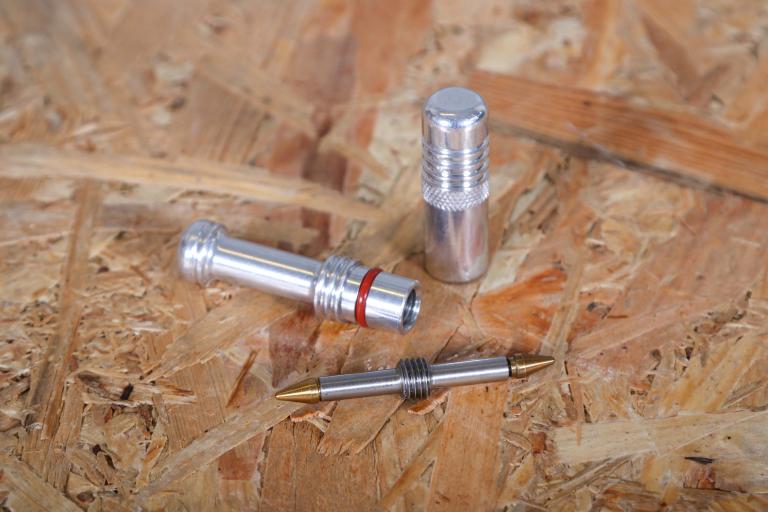
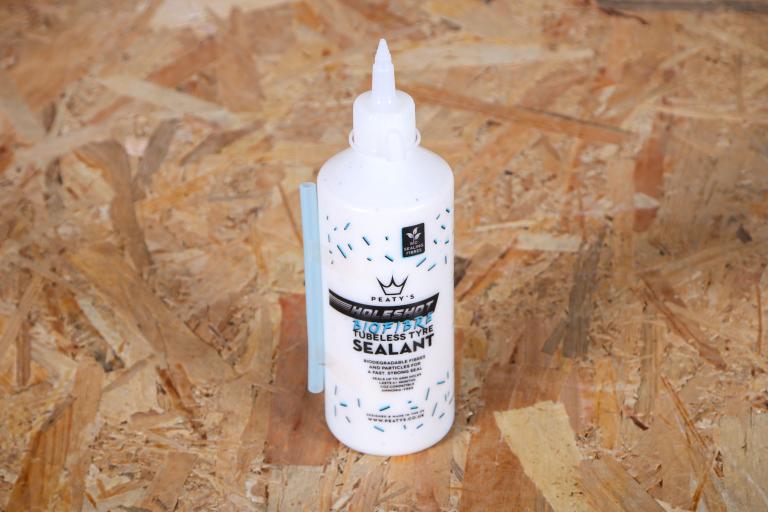
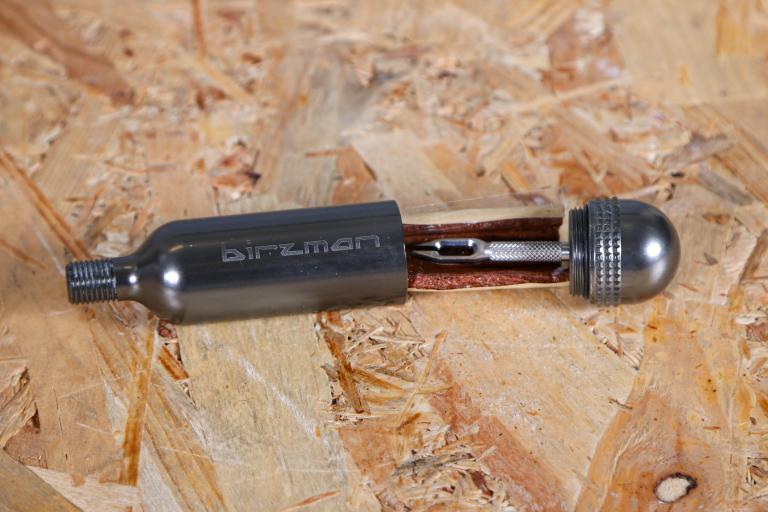
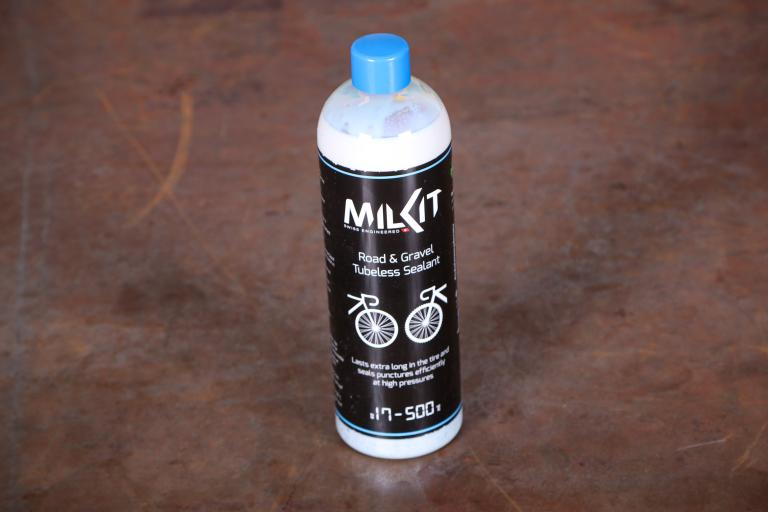
Add new comment
15 comments
It doesn't work. Don't waste your money. Simply filed to seal any type of puncture - some were so small I couldn't find them... It might be good for the environment but it isn't any good at anytihng else.
I know the particular doesn't always reflect the general but I shall vent my feelings about my experiences with tubeless over the last eight months.
New bike build, why not go tubeless? These were my thoughts last spring and so I assembled all the necessary bits and pieces. After a minor amount of inconvenience all was well, the tyres were pumped, Uncle Stan's sealant was installed and the bike was superb. And so it continued until the August bank holiday when I collected a 6mm gash in the front Hutchinson. Despite my best efforts it failed to seal itself, even with the aid of a plug, and I finished our 200 mile ride on a tube which behaved impeccably all weekend.
When I got home I dismissed the affair as a blip; after all it had been a pretty large hole. And so I reinstalled the valve, put in some more gloop and rode on. All was well until a month ago when I suffered a very different flat. A tiny hole in the rear tyre caused a slow deflation which, once again, Uncle Stan's finest was completely unable to seal. Being only a mile from home I eventually gave up fiddling with the slimy mess and walked back, where I switched once more to tubes.
If the sealant can't cope with larger holes or, it would seem, very tiny ones, I won't be returning to tubeless until some significant breakthrough is made. You live and you learn.
I should add here that although I am relatively inexperienced with tubeless, on both rides I had the benefit of much advice ( and hilarity ) from my friends, some of whom have used the system for years. Nobody could make the sealant work and most of us ended up wearing a liberal coating of the stuff.
It depends on the sealant and type of puncture that determine how effective tubeless is. I've had 'cuts' that haven't sealed due to their size, though one of those was very successfully fixed with a plug but it seems to work better with smaller holes e.g. thorns.
I've not used Stan's on road tubeless - I've been using Effetto Caffelatex and from what I can tell, it seems to do the job. When I run out of the big 1L bottle that I've just started, I might try this version as using olive remains seems a good idea.
When I read "During a month of testing, I've been impressed with how it's repeatably sealed punctures quickly and easily,....." I wondered what Jamie Williams is doing with his bike. The last puncture on my road bike was 8300km ago and gravel bike 2300km ago. The other 2 bikes total over 8000km since the last puncture. I reckon you guys with tubeless spend more time in 6 months working with sealant than I've spent fixing punctures in the last 3 years.
Hi Dingaling,
At the time of writing I'd managed to rack up about 2000km between my commuter and winter bike both using the sealant. With a lot of my riding on glass laden cycle paths as well as dirty Welsh lanes and some off-road riding thrown in for good measure I sadly get punctures very regularly no matter what tyres I use.
Cheers,
Jamie
I read 'Hutchinson' and the following is just anecdotal but still: before binning them for totally different reasons, the only tyre that I ever rode that gave me trouble with Stans Race sealant was a Hutchinson sector,. Even tiny holes had difficulty sealing. I have no explanation but on both my Schwalbe and pairs of René Herse Bon Jon pass and Barlow Pass extralight tyres (if you want to see what a thin sidewall looks like, get these) it performed flawlessly.
That said, it seems tubeless is -at least on road bikes- still very much a you love it or hate it affair, with many variables thrown in such as the tyre, rim etc.
I've used a tyre sealant for many years which works well - it's basically a preformed circular tube of latex with a valve attached to it. No mess and easy to install. It just works.
That sounds perfect - how many punctures can it seal before needing replacement?
I can't say, I've never had a puncture. That's because I look where I'm going...
You must cycle very, very slowly then.
Most Sundays I do a training run of between 60km and 100km (over rolling terrain) and average in the low 30s (km/h). Not exactly pro standard, but not too shabby for someone closing in on 60.
And to flesh it out a bit: it's totally true that I never get punctures (in 10 years of riding with a 'saddle like a razor blade'). I check tyre pressure (and tyre condition) every day, I look ahead while riding, and (most importantly) I ride on Swiss roads. The 'marginal gains' add up...
That probably says more about the quality and condition of Swiss roads vs <Insert other country>'s roads than anything to do with speed, observation skills or tubes vs tubeless...
I presume that was said tongue in cheek, if not you win the patronising post of the year award.
I can almost hear the puncture fairies lining up to attack your tyres after a statement like that.
I lived on the border of France with Switzerland for a few years in the 90s. Punctures were very rare there. Then my job finished and I came back to UK and resumed riding in the Chilterns. God Almighty. Those lanes were hard on 90s era tyres. I spent many cafe stops fixing the inner tube that had flatted on the first half of the ride. Going tubeless back in 2015 has been a game changer and I can't remember the last time a puncture stopped me at the side of the road. In fairness, modern clincher tyres are more puncture resistant than those of 20 years ago but I still see many references on my Strava feed to people having to stop to fix inner tubes.